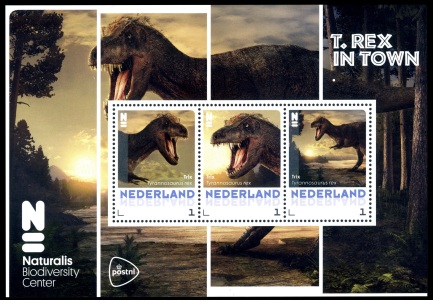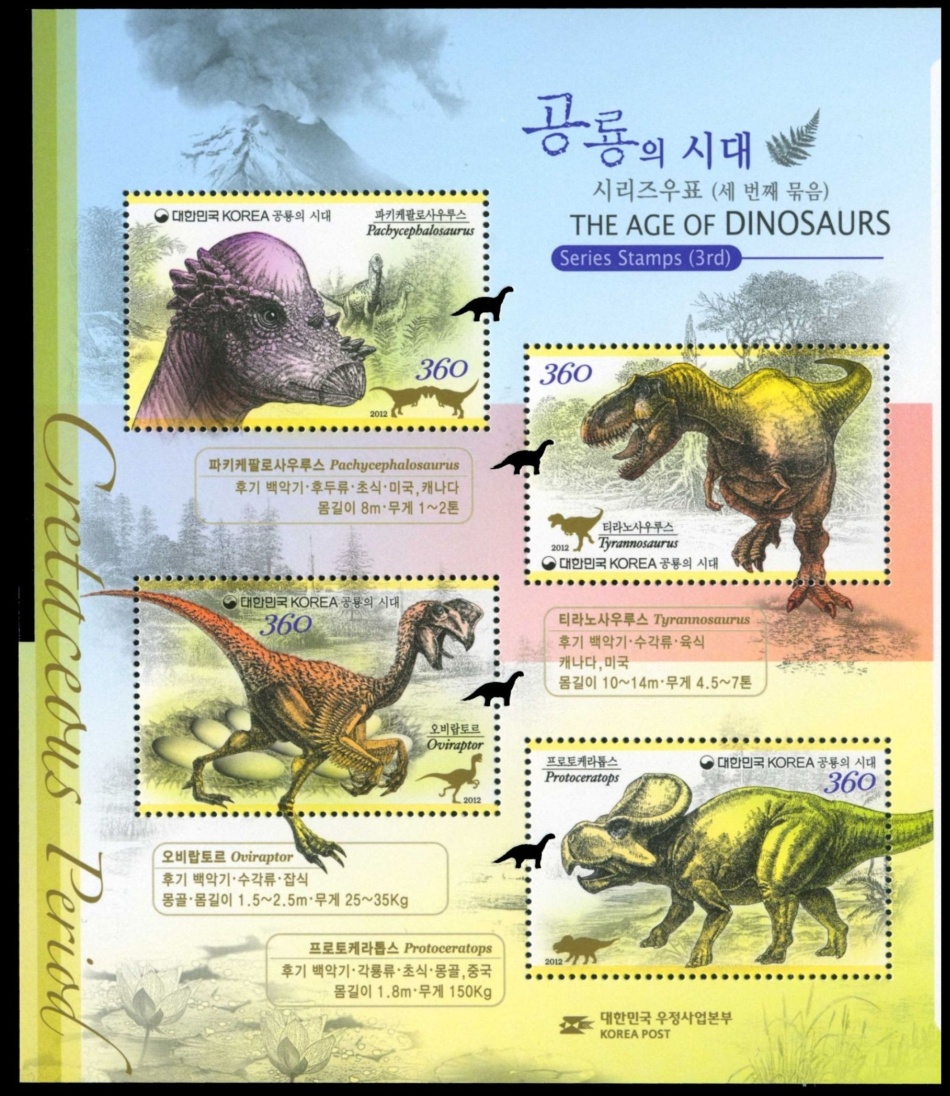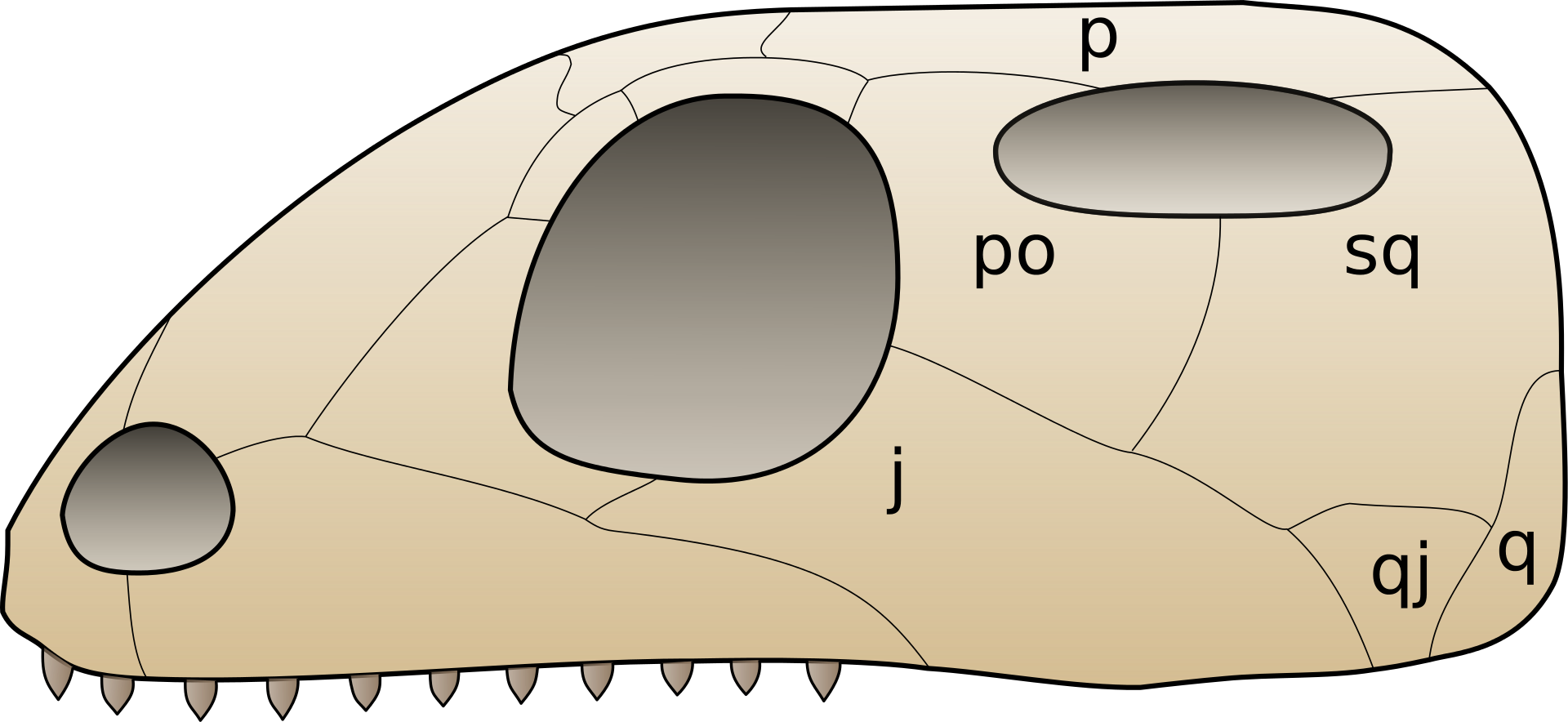the place where Paleontology and Paleoanthropology meets Philately
Vertebrate Paleontology
Vertebrates are members of the Phylum Chordata.
Chordates have a dorsal nerve cord protected by a notochord.
A notochord is a stiff rod of cartilage that protects the dorsal nerve cord; in vertebrates this structure has evolved into the vertebral column that protects the spinal cord.
Note: the phylum chordata does include invertebrates – the tunicates (sea squirts) and cephalochordates (the lancelets).
General Philatelic Resources on Vertebrate Paleontology
Philatelic posters for "X Brazilian Symposium of Vertebrates Paleontology" (philatelic exhibit by Prof. Dr. Antonio Carlos Sequeira Fernandes).
Amphibians
Amphibians are semi-aquatic tetrapods.

|

|

|

|

|

|

|

|

|

|

|

|

|

|

|

|

|

|

|
Most amphibians have permeable skin, though modern Caecilians do have some scales. Their eggs are gelatinous. The permeable skin and gelatinous eggs restrict amphibians to moist environments.
Many modern amphibians undergo metamorphosis, a transformation from a usually aquatic, fish-like larva to an adult. Modern Amphibians include frogs, salamanders and caecilians evolved in the early Mesozoic. There is also a variety of early stem tetrapods (transitional species between sarcopterygian fish and amphibians) and early Amphibians from the Paleozoic.
Articles:
Fossil Amphibia on Stamps (by Dr. Peter Voice, pdf reprinted from Biophilately Magazine)
Birds
Birds or Avian Dinosaurs are closely related to the Theropod Dinosaurs.Their anatomy is characterized by adaptations for flight, including the modification of the front limbs into the bones supporting the wings, a strongly keeled sternum, and a coating of feathers. Feathers likely developed in a manner similar to the development of fur in mammals – initially as invaginations of the epidermis that developed filaments, followed by the development of barbing that interlocked adjacent filaments.
The keeled sternum provides a large surface area that the muscles that power flight attach to – the muscles then extend to the shoulder and upper arm.
Birds also exhibit a reduced and fused tail bone, the pygostyle.
Articles:
Palagornis from Peru.
Evolve - A Beak at Evolution (philatelic exhibit by Mr. Vijay Wadhwa).
Fishes
Fishes are aquatic animals that live in marine or freshwater environments.They “breathe” using gills that absorb oxygen from water. Fish are divided into 5 major classes – Agnatha, Placodermi, Chondrichthyes, Acanthodia and Osteoichthyes.
-
Agnathan fish today include the lamprey eels and hagfish found primarily in marine waters.
Agnathan fish have worm-like bodies.
Their mouths are fixed open as they are jawless fish.
The Agnatha first appeared in the Cambrian.
Most Agnathan fish do not have paired sets of fins – a unifying characteristic for all other classes of fish. -
Placoderm fish have articulated jaws – so they could open and close their mouths.
Placo refers to plates and derm to skin – so these fishes have massively armored plates that cover the front half of the body. The rest of the body was covered with small scales.
Placoderms are found in Silurian and Devonian aged rocks, but died out by the end of the Devonian. Bothriolepsis, a placoderm fish, is found on a stamp from Latvia. -
The Chondrichthyean fish include sharks and their relatives.
Their skeletons are made up primarily with cartilage with a few ossified elements including teeth and sometimes the vertebrae.
Sharks likely evolved during the Ordovician, but conclusive fossil evidence show that they were present in Silurian seas. -
Acanthodians are sometimes classified as a subclass within the Osteoichthyes – as they do have bony struts that support the fins.
The rest of the Acanthodian skeleton is made up of cartilage.
Acanthodian fish are found in Silurian to Permian-aged rocks and died out in the terminal Permian Mass Extinction Event. -
Osteoichthyean fish have mineralized skeletons of bone composed of apatite.
The Class Osteoichthyes is split into 2 major groups – both with extant members.
-
The Actinopterygii are commonly referred to as “ray-finned fishes” as their fins are supported by a series of small bony struts.
The far majority of fish living today belong to the Actinopterygii and include fish like the goldfish.
This group first appears in the early Silurian and become the dominant group of fish in the Triassic.
-
The Sarcopterygii have two sets of fins that articulate with the main skeleton through a pectoral (shoulder) and a pelvic (hip) girdle.
The bones that make up the fins consist of a series of bones that are homologous to the bones of the limbs of tetrapods.
Sarcopterygian fish are commonly referred to as the lobe-finned fish.
Sarcopterygian fish include the modern lungfish (fish that are capable of briefly living on land – with 4 modern species found in Africa, South America and Australia) and the coelacanths.
Coelacanths were rediscovered in the early 20th century as living animals – they had been thought to be extinct.
Modern Coelacanths are found off the coast of western Africa from South Africa to Kenya as well as in the vicinity of Madagascar and the Comoros Islands.
A second population has been found in the waters of Indonesia north of the island of Sulawesi.
Sarcopterygian fish first appear in the Silurian and are closely related to the Tetrapods.
-
The Actinopterygii are commonly referred to as “ray-finned fishes” as their fins are supported by a series of small bony struts.
 Dr. Hans Ulrich Ernst, coauthor of the book is an active member of the German
Mining and Geoscience Philatelic Club
(Arbeitsgemeinschaft Bergbau und Geowissenschaften),
where he has published many paleophilately-related articles.
Dr. Hans Ulrich Ernst, coauthor of the book is an active member of the German
Mining and Geoscience Philatelic Club
(Arbeitsgemeinschaft Bergbau und Geowissenschaften),
where he has published many paleophilately-related articles. The book is aimed at those collectors interested in philately and in fossil fish.
There are detailed descriptions and images of all manner of items related to fish paleophilately including stamps, postmarks and postal stationary known to the date of publication.
The book also includes detailed descriptions of each type of fossil fish depicted on philatelic materials including a brief discussion of fish classification, biology and anatomy, and their fossil record.
Photographs of fossil fish are included for each species depicted on a stamp. The publishers of the book have provided preview pages here. You can still buy this book on Amazon: USA, UK, DE
Articles:
Actinopterygian fish Nematonotus longispinus from Lebanon.
Placodermi from Latvia.
The African Coelacanth Latimeria chalumnae (philatelic exhibit by Mrs. Susan Bahnick Jones).
Mammals
Mammals are characterized by bearing hair – where the development of hair follicles likely followed a similar pathway to the evolution of filamentous feathers in dinosaurs and birds.Mammals are members of the amniota – amniotes are vertebrates that lay or had ancestors that laid hard-shelled eggs with internal sacs that supplied the embryo with nutrients and stored waste products.
Reptiles and Birds are also amniotes.
Monotremes are the only living mammals that lay eggs – they include the Duck-billed Platypus and several species of Echidna that are limited to Australia and New Guinea.
The other modern branches of the Mammalia, Marsupials and Placentals both give live-birth.
Marsupials are only found on Australia and the Americas and include animals like the kangaroo, koala and opossum.
Placental mammals are the dominant group today and include everything from Mice to Humans.
Mammals had greater diversity in the Mesozoic as there are several extinct lineages known from the fossil record.
The majority of these fossil mammals are known from teeth or jaw fragments as Mammals have distinctive teeth.
Female mammals feed their young with secretions of milk from their mammary glands.
Mammals are derived from synapsid reptiles.
The synapsids that are more closely related to mammals exhibited teeth differentiation with the development of canines, incisors, and molars. This trait was passed on to their mammalian descendants – and the shape and number of incisors, canines, premolars and molars is often diagnostic when identifying specific species of mammals.
Articles on Stamps Sets focused on several species of Mammals:
Prehistoric mammals of Nepal:
[1],
[2].
Ice Age prehistoric mammals of Great Britain.
Prehistoric mammals of USA
Articles on Stamps Sets focused on specific species of Mammals:
Carnivora
Cave Bear: Ursus spelaeus from Slovenia.
Cave Lion:
Panthera leo fossilis from Croatia,
Panthera leo spelaea from Slovenia
Probscidea - Elephants, Mammoths, Mastodons and their relatives:
Prehistoric elephants of Nepal
Mammuthus primigenius from Russia,
from Slovenia: [1] and
[2] .
Mammuthus meridionalis from Tajikistan.
Mammuthus Trogontherii from Armenia.
Mastodon from Slovenia.
Stegodons from India.
Ungulates
Ungulates are hoofed mammals – they are split into two major groups – even-toed ungulates (Artiodactyls) and odd-toed ungulates (Perissodactyls).
Artiodactyla:
Anthracotherium Magnum from Slovenia.
Megaloceros giganteus:
History of discovery (PDF versions: in English,
in German).
Discoveries in:
Ireland,
Isle of Man,
Russia.
Perissodactyla:
Prohyracodon telleri from Slovenia.
Pilosa:
Thalassocnus littoralis from Peru.
Cetacea:
Whales:
Basilosaurus of Wadi El-Hitan from Egypt,
Levyatan Melvillei from Peru,
Mesocetus agrami from Croatia.
Reptiles
Reptiles are amniotes with scaley skin.Historically, reptiles have been classified into 4 major groups based on the number and presence of temporal fenestrae.
Unlike amphibians, Reptiles do not exhibit a larval stage or metamorphosis. Most reptiles lay eggs, though a few reptiles evolved to give live birth – including some of the extinct aquatic reptiles like Ichthyosaurs.
Both scaley skin and the amniotic egg were adaptations that allowed reptiles to exploit drier terrestrial environments away from shore. Temporal fenestrae are openings in the skull behind the eye socket (orbit). The four groups include anapsids (parareptiles, turtles and tortoises) with no temporal fenestrae, synapsids (mammal-like reptiles) with one temporal fenestra, diapsids (most modern reptiles and many extinct groups; major groups include snakes and lizards, crocodiles, pterosaurs and dinosaurs) with two temporal fenestrae, and euryapsids (ichthyosaurs and plesiosaurs) which had one temporal fenestrae but evolved from diapsid ancestors who secondarily lost the lower temporal fenestrae.
More recent work has shown that turtles and tortoises are highly derived diapsid reptiles that secondarily lost both temporal fenestrae.
General References on Prehistoric Reptiles on Stamps:
Ancient Reptiles of New Zealand.
Prehistoric Marine Reptiles (philatelic exhibit by Mr. Rudolf Hofer).
Euryapsids
 Euryapsids are a group of reptiles that are distinguished by a single temporal fenestra, an opening behind the orbit, under which the post-orbital and squamosal bones articulate.
Euryapsids are a group of reptiles that are distinguished by a single temporal fenestra, an opening behind the orbit, under which the post-orbital and squamosal bones articulate.Euryapsids include Ichthyosaurs, Plesiosaurs and their close relatives.
The History of Ichthyosaurs Discovery.
Plesiosaurs discovery in Antarctica (Argentina).
Pliosaurus from Mexico
Pliosaurus rossicus from Russia.
Diapsids
 Diapsids are a group of amniote tetrapods that developed temporal fenestra, an opening behind the orbit, in each side of their skulls.
Diapsids are a group of amniote tetrapods that developed temporal fenestra, an opening behind the orbit, in each side of their skulls. The diapsids are extremely diverse, and include all crocodilians, non-avian dinosaurs, lizards, snakes and a bunch of other groups
Mosasaur from Denmark
Paraligator
Kansajsuchus extensus from Tajikistan.
Dinosaurs
Age of Dinosaurs (philatelic exhibit by Mrs. Romina Aimar).
Dinosaurs of Australia [1],
[2]
Dinosaurs of Belgium.
Dinosaurs of Canada:
[1],
[2].
Dinosaurs of China:
[1],
[2].
Dinosaurs in China and Mongolia (philatelic exhibit by Mr. Rudolf Hofer).
Dinosaurs in Europe (philatelic exhibit by Mr. Rudolf Hofer).
Dinosaurs of Israel.
Dinosaurs of Laos.
Dinosaurs of New Zealand.
Dinosaurs of Mongolia (on stamps of Poland)
Dinosaurs of Portugal:
[1],
[2].
Dinosaurs of Romania:
Tara Hategului,
Transylvania
Dinosaurs of South Africa
Dinosaurs of Singapore.
Dinosaurs of Thailand
Dinosaurs of the United Kingdom
Dinosaurs of USA:
[1],
[2],
Ankylosaurs:
Antarctopelta oliverois discovery in Antarctica (Argenitna).
Parasaurolophus:
Parasaurolophus from ROM Museum of Canada
Sauropods:
Aragosaurus (Spain),
Cetiosaurus mogrebiensis (Morocco),
Iguanodon from ISTRIA (Croatia)
Lufengosaurus (China),
Sabinosaurus from Mexico
Tazoudasaurus naimi (Morocco),
Titanosaur from Marília (Brazil).
Theropods:
150th anniversary of Archaeopteryx discovery,
"Lightning Claw" from Australia,
Tarbosaurus Bataar from Mongolia,
Tyrannosaurus rex(Naturalis Museum) from the Netherland ,
Tyrannosaurus rex from USA.
The Complete Trex (philatelic exhibit by Mr.Fran Adam).

|

|
Both books are by Rubén Molina-Pérez and Asier Larramendi, the founders and scientific directors of Eofauna, a company that produces scientifically accurate representations of prehistoric fauna.
These books are very well illustrated by famous paleoartists and provides very detailed information about these groups of Dinosaurs: comparisons of the size of species, how long ago they lived, and when they were discovered, shows the positions of the continents at different geological time periods, compares bones, teeth, and feathers and many more.
Both books are available on Amazon
The Sauropods: USA, UK, DE
The Therapods: USA, UK, DE
Pterosaurs
Muzquizopteryx coahuilensis from Mexico.
Pterosaurs (philatelic exhibit by Mr. Rudolf Hofer).
Synapsids
 Synapsids are a group of animals that includes mammals, mammal-like reptiles and every animal more closely related to mammals.
Unlike Euryapsids, they have a temporal fenestra, an opening behind the orbit, low in the skull roof behind each eye,
leaving a bony arch beneath each.
Synapsids are a group of animals that includes mammals, mammal-like reptiles and every animal more closely related to mammals.
Unlike Euryapsids, they have a temporal fenestra, an opening behind the orbit, low in the skull roof behind each eye,
leaving a bony arch beneath each.
Inostrancevia alexadri.
Prehistoric mammals of South Africa.


Do you have any question or want to talk about your hobby with collectors who share the same interest?
Looking for swap partners ?
Join more than 700 members of the "PaleoPhilately" group on Facebook
Acknowledgements:
Many thanks to Dr. Peter Voice from Department of Geological and Environmental Sciences, Western Michigan University, for the draft page review and especially for the summary descriptions of the major groups of vertebrates in this article.